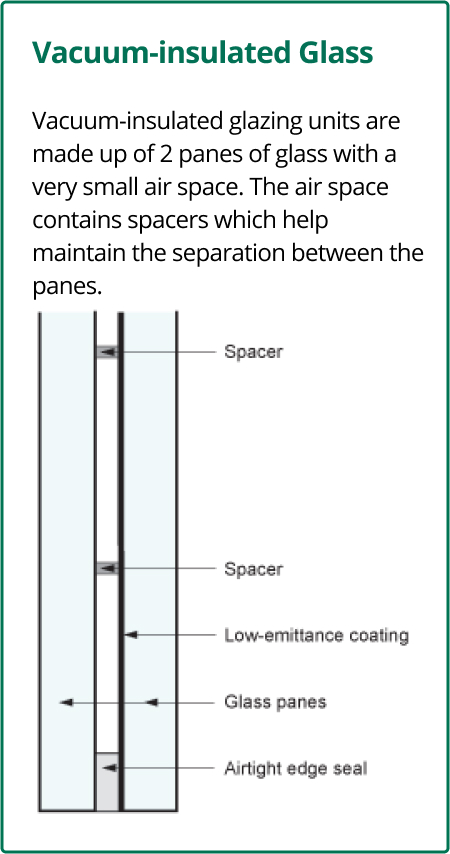
Window Technologies: Emerging Techniques-Glass
Most of the emerging glass technologies are available or nearly on the market. These include insulation-filled and evacuated glazings to improve heat transfer by lowering U-factors.
Evacuated Windows
The most thermally efficient gas fill would be no gas at all—a vacuum. The window industry is pursuing the development of vacuum-insulated glass (VIG) for use in window units in which the space between the panes is evacuated. If the vacuum pressure is low enough, there would be no conductive or convective heat exchange between the panes of glass, thus lowering the U-factor. A vacuum glazing must have a good low-E coating to reduce radiative heat transfer—the vacuum effect alone is not adequate. This principle has been used in the fabrication of thermos bottles for many years, with the silver coating serving as the low-emittance surface.

The vacuum eliminates conduction and convection but not radiation, so a low-E coating is necessary on the pane of glass. Depending on the type of low-E coating, dual-pane VIG windows can have a U-factor of 0.20 or less while maintaining a high SHGC. VIGs have the advantage of being thin (0.20–0.43 inch) and thus suitable for many facade designs, including retrofits.
Evacuated window assemblies present a number of engineering problems, however. One major issue is the structural requirement to resist normal air pressure and variable pressures caused by wind and vibration. There can be large thermal stresses between large, window-sized panes of glass. A thermos bottle resists these forces easily because of its strong curved shape, but the large, flat surfaces of a window tend to bow and flex with changing pressures. Small pillars or spacers are used to maintain the separation between the panes. The pillars are very small but are somewhat visible, reducing the window clarity.
Another issue is the maintenance of an airtight seal around the unit edge. The seal must be maintained to eliminate gaseous conduction by keeping the air density within the unit to less than one millionth of normal atmospheric pressure; an air density of only ten times this amount is sufficient to re-establish conduction to its normal value. This vacuum seal must remain intact for the life of the window, through manufacture, transportation, installation, and normal operation, wear, and weathering.
Insulation-Filled Glazings
There are several options for highly insulating windows with aerogel, honeycombs, and capillary tubes located between glazing panes. These materials provide diffuse light, not a clear view. Some of these materials are used in Europe for passive solar applications.
Aerogel is a silica-based, open-cell, foam-like material composed of about 4% silica and 96% air. The microscopic cells of the foam entrap air (or another gas if gas-filled), thereby preventing convection while still allowing light to pass. The cell sizes are smaller than the mean free path of air/gas molecules, thus reducing conduction to values below those of pure conduction for the air/gas. Long-wave thermal radiation is virtually eliminated due to the multiple cell walls through which long-wave infrared radiation must be absorbed and reradiated. The particles that make up the thin cell walls slightly diffuse the light passing through, creating a bluish haze similar to that of the sky.
Aerogel has received research attention for its ability to be both highly transparent and insulating, making it one of a number of materials that are generically referred to as transparent insulation. It should be technically possible to produce windows made of aerogel with a center-of-glass U-factor as low as 0.05. However, aerogel has only been produced in small quantities and sizes, so only tile-sized samples have been used as windows for research purposes. European manufacturers have produced double-glazed windows filled with small beads of aerogel and while the units have good insulating values, they are diffusing and do not provide a view. Aerogel might find a future application as a component of a larger window system, such as spacers between insulating panes of glass, or in skylights or glass blocks.